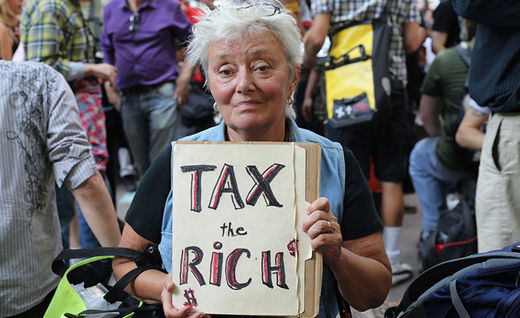
WASHINGTON – Auditors at the IRS generally do a decent job identifying how much wealthy taxpayers are trying to shortchange Uncle Sam. But the understaffed IRS is only examining a fraction of the returns the wealthy file, just 12.1 percent of returns reporting over $1 million in income.
How much in additional taxes due might the IRS identify if audit rates rose? Plenty. On 2011 returns, just-released figures show, the IRS found an average of $117,116 in taxes due on each return it examined that reported more than $1 million in income. If the IRS had examined all 2011 returns reporting over $1 million, the total taxes due identified from millionaire filers would have likely leaped from the $4.9 billion actually identified to $39.7 billion.
CEO pay, USA Today reported (before the AFL-CIO released its comprehensive Executive Paywatch data on April 15) rose eight percent last year, a figure calculated to include the value of new stock and option awards execs grabbed in 2012. But if we examine instead what CEOs actually took home last year, after cashing out awards granted in previous years, their pay hike soars to 40 percent!
“I’m shell-shocked. I can’t believe this can go on,” said John Bogle, founder of the Vanguard mutual fund company. An AFL-CIO-sponsored website (below) will let you know the latest CEO pay-and-perk data, which CEOs offshore jobs, too, and if Bogle’s mutual fund (and others) are enablers of such lavish compensation packages.
The high pay and perks don’t much bother Rep. Bill Huizenga, R-Mich. He’s introduced a bill to repeal the 2010 Dodd-Frank Act provision that requires firms to disclose the ratio between what they pay their top exec and typical workers.
No firms have yet had to make this disclosure, since the Securities and Exchange Commission still hasn’t written the regulations necessary to enforce it, thanks to CEO lobbying. Right Wing Rep. Nan Hayworth, R-N.Y., a Tea Partyite, introduced a similar ratio repeal in 2011. Voters repealed Hayworth last November.
More complete data – much more complete than in USA Today – is at www.executivepaywatch.org. It also has links for you act against the CEOs’ pay abuses, once your blood pressure drops…
Meanwhile, Palm Beach – the 16-mile barrier island just off Florida’s coast – boasts a heavier concentration of awesomely affluent than any other zip code in America. What Palm Beach also boasts: More periodicals per capita than any place in the world. The 5,000 households of Palm Beach can partake of Palm Beach Life, Palm Beach Illustrated, Palm Beach Design, Palm Beach Woman, Palm Beach Society, and the venerable Palm Beach Daily News, a paper printed on newsprint “that prevents ink from smudging on well-manicured fingers.”
What makes these pubs so popular? Endless pages devoted to photos from the Palm Beach party scene. The lushest annual party? That may be the March gala of the local historic preservation society. This year’s gala turned a ballroom “into a white Russian winter fantasy, complete with ballet dancers and ice sculptures of giant bears.” In Palm Beach…yeah, right.
On another front, this week’s award for Petulant Plutocrat Of The Week goes to Rebecca Arbogast. She works for cable giant Comcast, whose five top execs at cable giant Comcast are each making, at last count, over $15 million. CEO Brian Roberts, Executive Paywatch reports, made $29 million last year, all by himself.
What Roberts and his Comcast colleagues are not making: Much progress narrowing the broadband speed gap between the United States and other nations. No problem for Arbogast, the firm’s public policy vice president. Her job: Justifying dismal U.S. broadband performance. Her strategy: Total denial.
Public angst over the “alleged failing” of U.S. broadband, she’s charging, rests on “disinformation.” Contrasts with nations like South Korea rate as “silly at best.” One purveyor of this “silliness,” NetIndex, last week had the United States 33rd globally in speed. Arbogast’s attitude isn’t surprising to industry analyst Karl Bode. “Denial has long been the battle cry” of broadband’s corporate giants, “who’d prefer things stay exactly as they are…uncompetitive and costly,” he says.
And now, let’s measure what we treasure: What if inequality in America had not grown over recent decades? Where would we be now? In Maryland, a landmark new report vividly relates, families in the state’s poorest fifth would be making twice the $15,000 they take home today if they held the same income share Maryland’s poorest held back in 1968.
And if Marylanders remained as equal today as then, the state would also have less crime, fewer divorces, and better health. How do we know? Maryland has, since 2009, been collecting data on the 26 measures of social, environmental, and economic well-being that make up the Genuine Progress Indicator, or GPI. Unlike the standard “GDP,” this new study notes, the GPI measures what matters – and can help people understand the terrible price we pay for tolerating inequity.
Sam Pizzigati is the editor of “Too Much”
Photo: Flickr (CC)

MOST POPULAR TODAY

Zionist organizations leading campaign to stop ceasefire resolutions in D.C. area


High Court essentially bans demonstrations, freedom of assembly in Deep South

Afghanistan’s socialist years: The promising future killed off by U.S. imperialism

Communist Karol Cariola elected president of Chile’s legislature






Comments